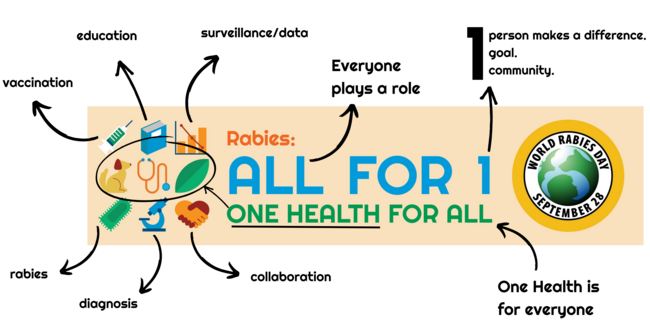Rabies All For 1 : One Health for All
Introduction
In a world committed to the ideal of “One Health, Zero Death,” the fight against rabies presents both a daunting challenge and an extraordinary opportunity for collective action. Rabies, a viral disease that affects mammals, is an enduring public health threat with far-reaching consequences for humans, animals, and ecosystems alike. This essay will navigate through the intricate dimensions of rabies, shedding light on its origins, it’s devastating impact, and the comprehensive strategies required to realize the ambitious goal of “One Health, Zero Death.”
- Rabies Unveiled: The Lethal Threat: Rabies is 100% fatal
But 100% vaccine preventable disease
- The Rabies Virus: Anatomy and Transmission
Rabies is an ancient disease and has been known since around 2300 BC. The word Rabies is derived from Sanskrit word rabhas means to do violent. The Greeks derived the word lyssa, means “violent”; this root is used in the genus name of the rabies virus, Lyssavirus. Rabies is a zoonotic disease. It is single-stranded RNA Virus. belong to family Rhabdoviridae, genus Lyssa virus.
To understand the menace of rabies, we must first dissect the virus responsible for this disease. The virology of rabies reveals a cunning pathogen with unique mechanisms of infection. It is characterized by its neurotropic nature, which means it targets the nervous system, making it particularly lethal. Furthermore, exploring the routes of transmission and identifying common vectors – typically all mammals like dogs, Cat, Mongoose and monkey – illuminates how the virus spreads from one host to another, underlining the complexity of controlling its transmission.
- A Global Scourge: The Human and Animal Toll
Rabies is not confined by borders; it’s a global scourge. Examining the incidence of rabies cases worldwide and its geographic spread paints a grim picture of its ubiquity. However, the true gravity of rabies lies in the human and animal toll it exacts. The number of human fatalities and the economic losses incurred in the agriculture and veterinary sectors serve as stark reminders of the devastating impact of this disease on both lives and livelihoods.
- Embracing One Health: Uniting Humans, Animals, and the Environment
- Defining One Health
“One Health” is more than just a catchphrase; it’s a philosophy that recognizes the interconnectedness of human, animal, and environmental health. Understanding the significance of holistic approaches in disease control is pivotal in the battle against rabies. By addressing the health of all these components together, we not only combat the disease effectively but also preserve the delicate balance of our ecosystems.
- Rabies as a Case in Point for One Health
Rabies serves as an exemplar of the One Health approach due to its zoonotic potential, meaning it can jump from animals to humans. Bridging the species gap in disease transmission highlights the importance of collaborative efforts between veterinary and medical professionals. Additionally, recognizing the role of environmental factors in rabies transmission emphasizes the need for an integrated approach that considers ecological factors, such as the habitat and behavior of reservoir animals.
III. Vaccination: The Keystone of Rabies Prevention
- Safeguarding Human Lives: The Importance of Vaccination
Preventing rabies in humans is a top priority, and vaccination is the key. Understanding the concepts of pre-exposure and post-exposure prophylaxis is essential. Pre-exposure vaccination protects individuals at higher risk of exposure, while post-exposure prophylaxis is crucial for anyone bitten by a potentially rabid animal. Overcoming barriers to universal human vaccination, such as access to vaccines and education, is imperative to reduce human rabies cases.
- Breaking the Chain: Animal Vaccination Strategies
To eliminate rabies, it’s not enough to focus solely on human vaccination. Mass vaccination campaigns targeting animal reservoirs are equally critical. These campaigns, when properly executed, can break the transmission chain, protecting both humans and animals. A tailoring vaccination strategy to different animal populations, from domestic pets to wild animals, is vital for comprehensive rabies control.
- Knowledge and Awareness: Empowering Communities
- Spreading the Word: From Urban Centers to Remote Villages
Effective communication methods play a pivotal role in raising awareness about rabies prevention. Dispelling myths and misconceptions surrounding rabies is essential to encourage responsible pet ownership, safe interactions with wildlife, and timely medical treatment after potential exposure.
- Empowering the Frontline: Veterinarians, Healthcare Workers, and Local Leaders
Training and capacity-building programs are instrumental in empowering those on the frontline of rabies control. Veterinary professionals, healthcare workers, and local leaders are the unsung heroes in this battle. They need the knowledge and resources to diagnose, treat, and prevent rabies effectively. Local leadership is particularly crucial in grassroots efforts to reduce rabies incidence.
- Confronting Challenges: Policy, Implementation, and Global Cooperation
- Legal Frameworks and Policy Initiatives
National and international rabies control initiatives, guided by legal frameworks and policies, provide the necessary structure for coordinated efforts. Advocating for rabies prevention within global health agendas ensures that this critical issue receives the attention and resources it deserves.
- Global Collaboration: A United Front against Rabies
Rabies knows no boundaries, and its control demands international cooperation. Knowledge sharing and collaborative research are essential for developing new tools and strategies. Mobilizing resources for a worldwide rabies eradication effort is a collective responsibility that necessitates concerted action from governments, organizations, and individuals alike.
Conclusion
In the pursuit of “One Health, Zero Death,” the battle against rabies looms large. Through a comprehensive approach encompassing vaccination, education, and global cooperation, we can envision a world where rabies is relegated to history. By prioritizing the health and well-being of all species, we take a significant stride toward a safer and more harmonious global community. Together, we can make “One Health, Zero Death” by 2030 not just an ideal but a tangible reality, where the threat of rabies no longer casts a shadow over our world.
Dr. Hemant Kumar Gohil
Email: arnavgohil!@gmail.com
Mob. No.: 9968097505


